Diving Santa Barbara Island, Channel Islands National Park
6 Comments
Of the five islands that make up Channel Islands National Park, one has eluded me for a while. The smallest of the Channel Islands, Santa Barbara is only one square mile in size. However, I couldn’t be pleased with my explorations of the park until I visited each of its five islands. This fall, I found at least a satisfying way to photograph Santa Barbara Island.
Because the crossing takes about 3 hours each way, day trips would be very rushed. On the other hand, the exclusive concessionaire, Island Packers, usually schedules trips that leave you on the island for 2 or 3 days before the boat comes back to retrieve campers. Unless you engage in water activities, this is quite a long time for an island with less than 5 miles of trails. There are only about four camping trips each year, running from July to October – when many wildflowers (including the coreopsis) are no longer in bloom. In the past years, by the time I got serious about scheduling, either the 10-site campsite had been booked out, or Island Packers had no room for sea kayaks. Access to the ocean is limited to the landing cove, so I consider a sea kayak almost a necessity to travel further on the waters. If you want to be amongst the less than two hundred people who camp on Santa Barbara Island each year, you have to plan very early and hope for good weather.
This October, instead of a camping trip, I visited on a live-aboard diving boat, the Cee Ray, chartered by Ocean Safari Outdoors. Both boat and dive crews were friendly and helpful. Thanks for your help to this unfrequent diver! Ventura is closer to the northern Channel Islands, but Long Beach is a bit closer to the southern Channel Islands. Arriving the previous evening at the Long Beach Harbor was quite a different experience from the Channel Islands Harbor of Ventura/Oxnard. Whereas the former is filled with yachts and other small boats, the Long Beach Harbor is a huge shipping port with a very industrial-looking environment. As a prelude to a National Parks trip, this shocked me. My diving companions on the boat were also quite different from previous experiences, more urban, young, and ethnically diverse. The boat sailed at midnight, setting anchor near Santa Barbara Island well before dawn.
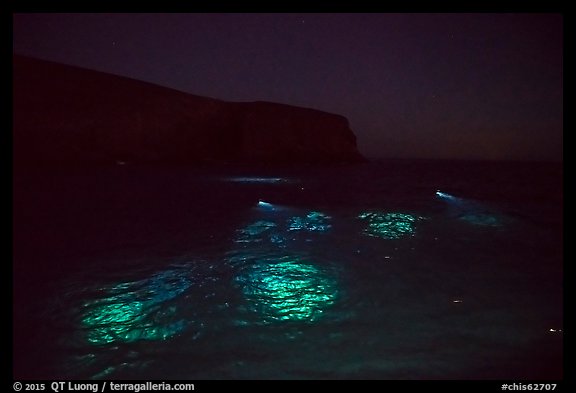
Walking onto the deck was like stepping in a different world with no signs of civilization visible nearby. A night dive took place, but since my last dive was 15 months ago, I chose to skip it. I didn’t want to fumble in the dark with diving gear, my camera, and a dive light, while going solo! However, I still got up early to photograph the curious glow of the underwater lights.
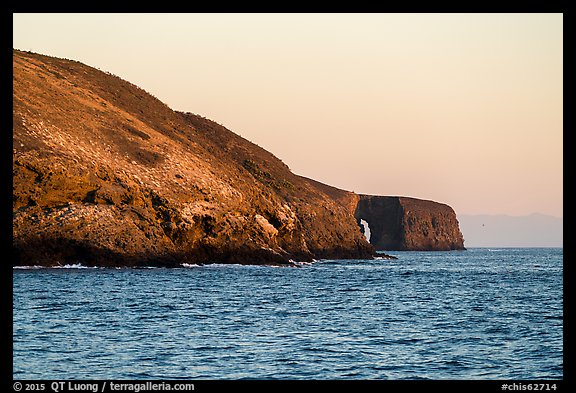
I stood mesmerized by the sight of Santa Barbara island emerging from darkness. Afterwards, the boat circled around the island in order to evaluate diving conditions. Since that took place at sunrise, it provided a range of views not accessible from shore with excellent light.
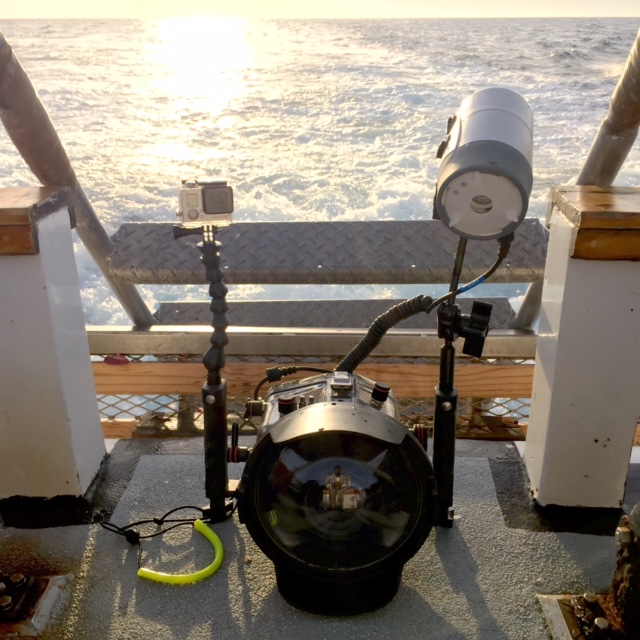
As I had learned on a previous diving trip in the Channel Islands, a diving boat provides far easier and comfortable access to diving sites than diving from the shore. It’s not even comparable. This time, instead of working with film, I used a Canon 5D mk2 and 17-40 f/4 lens with +4 diopter in the Ikelite underwater housing, together with the Ikelite DS160 strobe and a GoPro for video. Compared to the Nikonos, the rig is huge. Traveling with it is quite a drag, and hiking even more. In the water, it’s not really a problem since it becomes weightless. On a diving boat, a crew member simply handles your camera to you after you jump into the water.
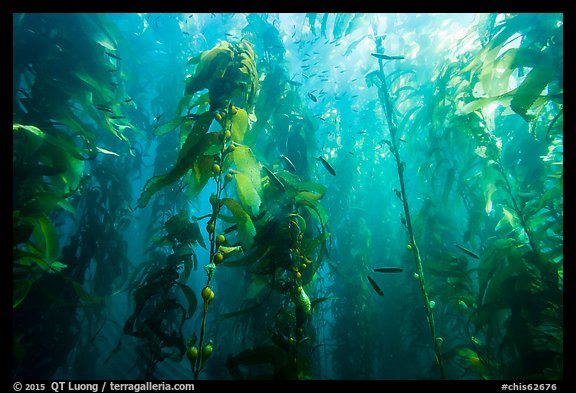
Like the other Channel Islands, Santa Barbara is surrounded by extraordinary underwater kelp forests. They are the fastest growing plants on earth, adding as much as 3 feet per day. Diving in the giant kelp forest is like being able to fly in a tall forest. These plants may exceed 100 feet in height. The possibility to photograph at high ISO proved useful to capture the details and colors of the tall columns of seaweeds rising deep from the ocean floor to the surface.
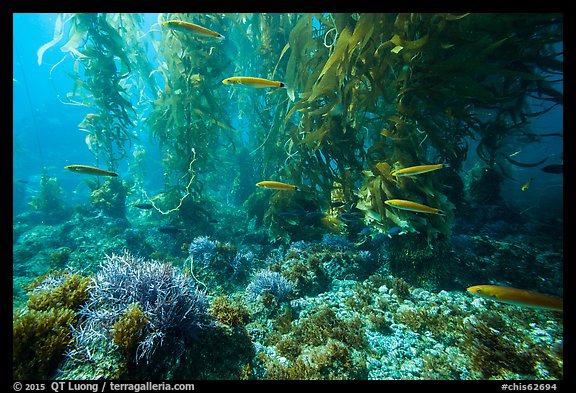
High ISO really came on its own when photographing on the ocean floor. It is quite a bit darker than the surface. With slide film, I did not have enough light for a proper exposure. Underwater photography is all handheld. You want to avoid contact with the ocean floor in order not to damage its cover, so you are drifting with underwater currents while you are trying to frame your shot – which may include lots of fish swiming around.
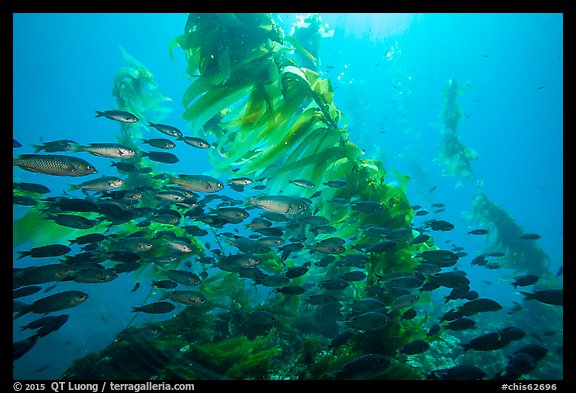
Faster shutter speeds freeze the motion of the abundant school of fish, however, it was still necessary to use the strobe to bring bring back the bright color of the Garibaldi fish. They are not shy! Many got too close for me to focus, and one of them even bumped my camera housing.
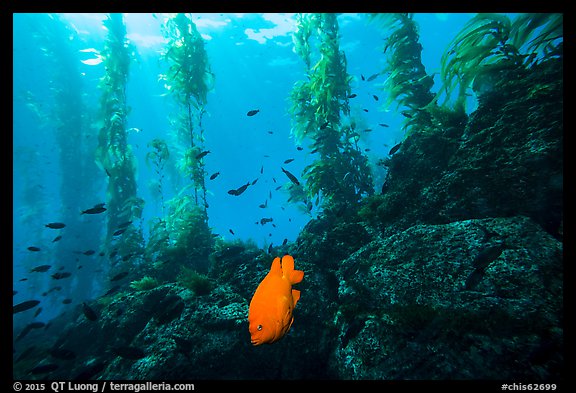
Santa Barbara Island is renown for its large colonies of playful sea lions. Sea lions are awkward on land, but their grace and speed underwater was a sight to enjoy. Since they can swim up to 30 miles per hour, and they like to twirl in all directions, I was glad to be able to use faster shutter speeds, and even more, to be able to shoot hundreds of frames on a memory card, as opposed to 36 frames on a roll of film.
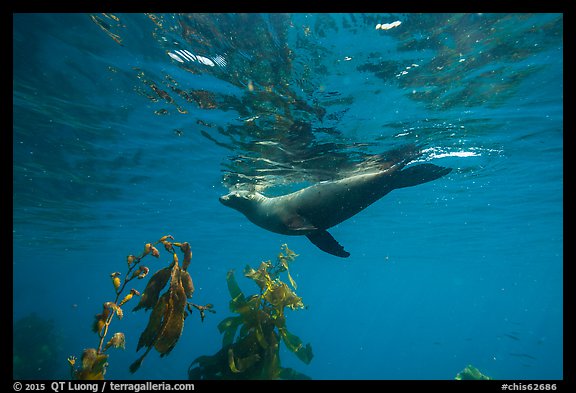
Swimming with the sea lions is a fantastic experience, as they are quite curious. A few of them swam towards me at great speed, blowed a few bubbles and veered sharply at the last second to avoid hitting me. The impact would hurt a bit more than a Garibaldi fish! I felt so privileged to be able to share for a moment the ocean with those intelligent creatures.
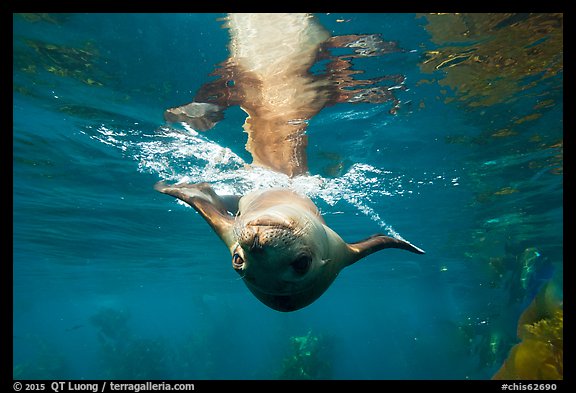
More images of Channel Islands National Park
More images of Santa Barbara Island


Another unique and fantastic post Tuan! We will be visiting the Channel Islands again in April, though not in the same way you have!
Thanks! April is a great time. It’s quite remarkable for an Australian to visit the Channel Islands twice. Most folks in California have no idea of their existence.
What a life you lead! 🙂
Yes, there are sacrifices involved in being a full-time photographer, but I am very grateful for days like that which make it worth it!
This sounds like a great experience, QT. Beautiful images too.
Great post and images as always QT! Of all the sports I’m involved in, diving has eluded me (and this amazing part of the Channel Islands).